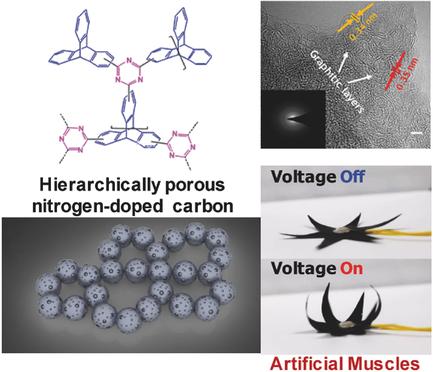Our official English website, www.x-mol.net, welcomes your feedback! (Note: you will need to create a separate account there.)
Electroionic Antagonistic Muscles Based on Nitrogen‐Doped Carbons Derived from Poly(Triazine‐Triptycene)
Advanced Science ( IF 15.1 ) Pub Date : 2017-10-11 , DOI: 10.1002/advs.201700410 Sandipan Roy 1 , Jaehwan Kim 1 , Moumita Kotal 1 , Kwang Jin Kim 2 , Il-Kwon Oh 1
Advanced Science ( IF 15.1 ) Pub Date : 2017-10-11 , DOI: 10.1002/advs.201700410 Sandipan Roy 1 , Jaehwan Kim 1 , Moumita Kotal 1 , Kwang Jin Kim 2 , Il-Kwon Oh 1
Affiliation

|
Electroactive soft actuators and bioinspired artificial muscles have received burgeoning interest as essential components in future electronic devices such as soft haptic‐feedback systems, human‐friendly wearable electronics, and active biomedical devices. However, important challenging issues including fast response time, ultralow input power, robust operation in harsh environments, high‐resolution controllability, and cost‐effectiveness remain to be resolved for more practical applications. Here, an electroionic antagonistic artificial muscle is reported based on hierarchically porous nitrogen‐doped carbon (HPNC) electrodes derived from a microporous poly(triazine‐triptycene) organic framework (PtztpOF). The HPNC, which exhibits hierarchically micro‐ and mesoporous structures, high specific capacitance of 330 F g−1 in aqueous solution, large specific surface area of 830.46 m2 g−1, and graphitic nitrogen doping, offers high electrical conductivity of 0.073 MS m−1 and outstanding volumetric capacitance of 10.4 MF m−3. Furthermore, it is demonstrated that a novel electroionic antagonistic muscle based on HPNC electrodes successfully displays extremely reliable and large bending deformations and long‐term durability under ultralow input voltages. Therefore, microporous polymer or covalent organic frameworks can be applied to provide significant improvements in electroactive artificial muscles, which can play key roles as technological advances toward bioinspired actuating devices required for next‐generation soft and wearable electronics.
中文翻译:

基于源自三嗪-三萜烯的氮掺杂碳的离子拮抗肌肉
电活性软致动器和受生物启发的人工肌肉作为软触觉反馈系统,人性化可穿戴电子设备和活性生物医学设备等未来电子设备中必不可少的组件,已引起了人们的强烈兴趣。但是,重要的挑战性问题包括快速响应时间,超低输入功率,在恶劣环境下的稳健运行,高分辨率可控制性以及成本效益等,这些对于更实际的应用而言仍需解决。在此,报道了一种基于微孔聚(三嗪-三茂)有机骨架(PtztpOF)的分层多孔氮掺杂碳(HPNC)电极的电离子拮抗人工肌肉。HPNC具有分层的微孔和中孔结构,具有330 F g -1的高比电容在水溶液中,较大的比表面积为830.46 m 2 g -1,并且掺杂了石墨氮,可提供0.073 MS m -1的高电导率和10.4 MF m -3的出色体积电容。此外,已证明,基于HPNC电极的新型电离子拮抗肌在超低输入电压下成功显示出极其可靠的大弯曲变形和长期耐用性。因此,微孔聚合物或共价有机骨架可用于显着改善电活性人造肌肉,随着下一代软,可穿戴电子设备所需的生物启发驱动装置技术的进步,其可发挥关键作用。
更新日期:2017-10-11
中文翻译:

基于源自三嗪-三萜烯的氮掺杂碳的离子拮抗肌肉
电活性软致动器和受生物启发的人工肌肉作为软触觉反馈系统,人性化可穿戴电子设备和活性生物医学设备等未来电子设备中必不可少的组件,已引起了人们的强烈兴趣。但是,重要的挑战性问题包括快速响应时间,超低输入功率,在恶劣环境下的稳健运行,高分辨率可控制性以及成本效益等,这些对于更实际的应用而言仍需解决。在此,报道了一种基于微孔聚(三嗪-三茂)有机骨架(PtztpOF)的分层多孔氮掺杂碳(HPNC)电极的电离子拮抗人工肌肉。HPNC具有分层的微孔和中孔结构,具有330 F g -1的高比电容在水溶液中,较大的比表面积为830.46 m 2 g -1,并且掺杂了石墨氮,可提供0.073 MS m -1的高电导率和10.4 MF m -3的出色体积电容。此外,已证明,基于HPNC电极的新型电离子拮抗肌在超低输入电压下成功显示出极其可靠的大弯曲变形和长期耐用性。因此,微孔聚合物或共价有机骨架可用于显着改善电活性人造肌肉,随着下一代软,可穿戴电子设备所需的生物启发驱动装置技术的进步,其可发挥关键作用。

























 京公网安备 11010802027423号
京公网安备 11010802027423号